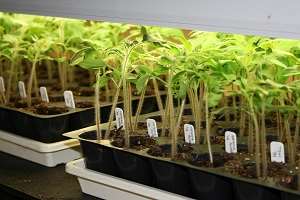By Dr. Gary R. Bachman
So far, it's been an interesting spring season in January for our gardens. New Year's weekend, more than 13 inches of rain fell in my Ocean Springs garden, followed a week later by freeze-magedden. By late January, we were in the middle of really nice, moderate weather.

So what plants do you think are showing up at garden centers? If you guessed vegetable transplants, you’re correct. Last week, I even saw large tomato plants full of flowers for sale in 6-inch containers.
Here in the middle of winter, there have been all kinds of leafy transplants ready for the garden. I’ve been taking advantage of the weather and have for the past couple of weeks been transplanting lettuce, spinach and Swiss chard.
But with all of the transplants in the garden centers, many gardeners are asking if they can grow their own transplants from seed. When the weather and temperatures are appropriate, almost all garden vegetables can be grown from seed, but growing them takes a lot of planning and forethought.
I don’t always plan that far ahead. I know from experience that I’ll decide on the spur of the moment I want to plant a certain vegetable, so in this situation, transplants are the only way to grow.
Regardless of the season they are planted, there are some home garden vegetables that just perform better from transplants. Tomatoes, peppers and eggplants are warm-season vegetables that should be transplanted. Cool-season crops you can plant right now from transplants include lettuce, kale, collards, broccoli and onions.
But why should we use transplants instead of direct sowing these vegetables?
Direct seeding in the cool soils of spring can result in soil-borne disease problems in the emerging seedlings. These diseases won’t affect transplants. Also, direct seeding always results in excess seedlings that have to be thinned, never one of my favorite chores.
But the best reason for using transplants is that the plants mature faster and produce faster. This head start is good for tomatoes, as they need to flower and set fruit before the heat of Mississippi summers sets in.
If your heart is set on growing your own tomato transplants, you’re in luck, because this a totally doable and fun activity. You have time to start now, as we are still several weeks before the last frost-free date.
Local garden centers have all the supplies you need. A good way to start is with a cell tray and clear dome -- sometimes called a seed-starting greenhouse -- that will allow you to grow about 50 seedlings. Fill the cell tray with a good, thoroughly moist, peat-based potting mix. Never use soil for growing your own transplants.
Place a couple of seeds into each cell because not all seeds will germinate. Gently water the seeds into the ground and cover with the clear dome. Voila, you have a mini greenhouse.
Place in a bright, sunny window or under fluorescent lights. Once the seeds start to germinate, remove the cover and keep the potting mix consistently moist. On nice days, take the seedlings outside in bright light but not direct sunshine.
In about six weeks, the little tomato plants will be ready to transplant. When the weather cooperates, you can set them out in the garden or a large container.
Source: msstate.edu